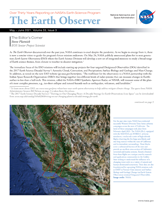The Earth Observer has a new look! Visit the NEW Earth Observer website.
The Earth Observer: May - Jun, 2021
In This Issue
Click title below to view page
- Feature Article
- Connected by Earth: Summary of NASA’s 2021 Virtual Earth Day Event 4
- Meeting/Workshop Summaries
- NASA’s SHADOZ Team Makes Advances in 2021 Despite the Pandemic12
- In The News
- How Scientists Are Using the International Space Station to Study Earth’s Climate18
- Dust Storms and Valley Fever in the American West21
- In a First, Scientists Map Particle-Laden Rivers in the Sky23
- Regular Features
- NASA Earth Science in the News25
- Earth Science Meeting and Workshop Calendar27
The Editor’s Corner
Steve Platnick
EOS Senior Project Scientist
As The Earth Observer documented over the past year, NASA continues to excel despite the pandemic. As we begin to emerge from it, there is now a concise vision to guide the program’s future mission endeavors. On May 24, NASA publicly announced plans for its next generation Earth System Observatory (ESO) where the Earth Science Division will develop a new set of integrated missions to study a broad range of Earth science themes, from climate to weather to disaster mitigation.
The immediate focus of the ESO missions will include starting up projects for four targeted Designated Observables (DOs) identified in the 2017 Earth Science Decadal Survey 2: Aerosols; Cloud, Convection, and Precipitation; Surface Biology and Geology; and Mass Change. In addition, as noted on the new ESO website (go.nasa.gov/3wmt4pm), “The trailblazer for the observatory is a NASA partnership with the Indian Space Research Organisation (ISRO) that brings together two different kinds of radar systems that can measure changes in Earth’s surface to less than a half-inch. This mission, called the NASA–ISRO Synthetic Aperture Radar, or NISAR, will measure some of the planet’s most complex processes, e.g., ice-sheet collapse and natural hazards such as earthquakes, volcanoes, and landslides.”
Read more...

